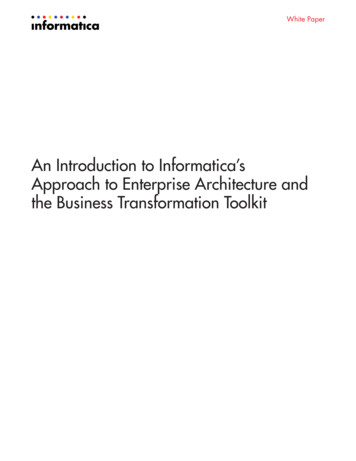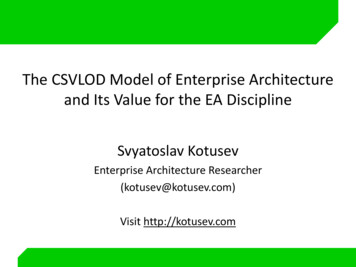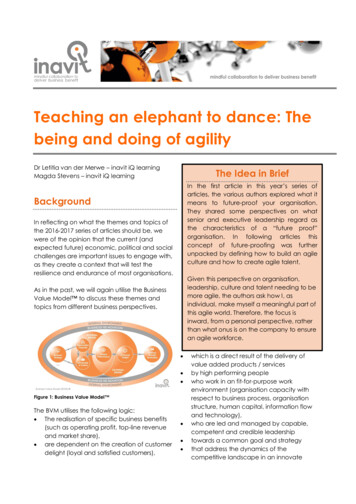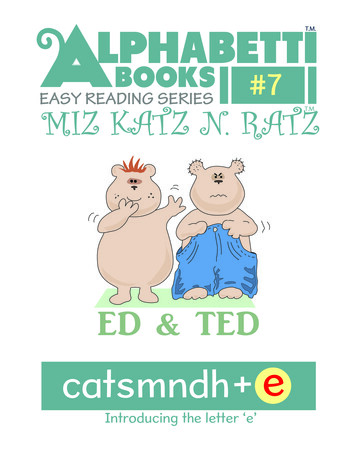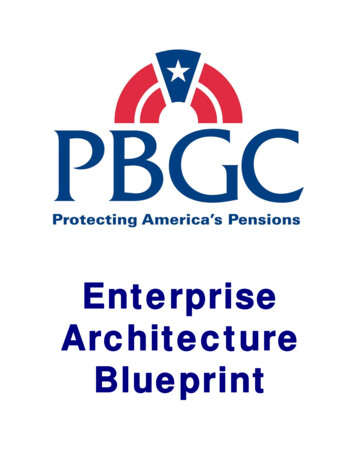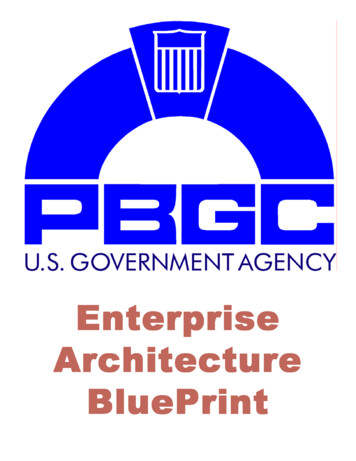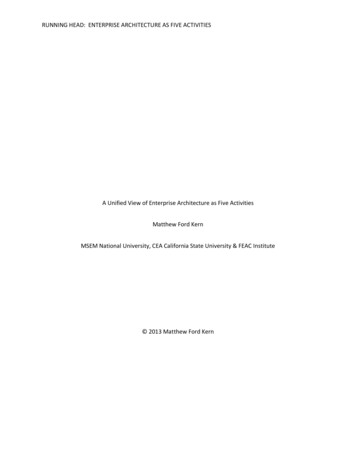
Transcription
RUNNING HEAD: ENTERPRISE ARCHITECTURE AS FIVE ACTIVITIESA Unified View of Enterprise Architecture as Five ActivitiesMatthew Ford KernMSEM National University, CEA California State University & FEAC Institute 2013 Matthew Ford Kern
A Unified View of Enterprise Architecture as Five ActivitiesAbstractLapalme describes enterprise architecture as if it implements one of three completely differentviewpoints, however Burk at OMB described enterprise architecture as having three differentlevels. Related, the PMBOK describes three levels of management. Hite at GAO describes afourth process of managing enterprise architecture itself. This paper presents a unified view,with five total enterprise architecture activities in the whole.IntroductionThere is an ancient story from the Indian subcontinent in which several men, either blind or inthe dark, try to describe an elephant. Each describes a different thing, as they have differentvantage points and touch different parts of the creature. None grasps the whole as a single being.Perhaps enterprise architecture sometimes has a similar problem.Burk at OMB (2006) suggests enterprise architecture has three levels.
A Unified View of Enterprise Architecture as Five ActivitiesFigure 1 shows the 3 levels of enterprise architecture from OMB 2006.Lapalme (2012) suggests enterprise architecture has three schools of thought.Figure 2 shows the 3 views of enterprise architecture from Lapalme 2012.The Project Management Institute in the PMBOK V5 (PMI 2013) holds that there are threelevels or types of management for initiatives (Concerning things that start and end, other thanfunctional management of continuous processes).PMBOK Level or TypeDescriptionPortfolio Management“Portfolios have a business scope that changes with thestrategic goals of the organization.”Program Management“Programs have larger scope and provide more significantbenefits.” Several projects may be organized into a program.Project Management“A project is a temporary endeavor undertaken to create aunique product, service or result.”Figure 3 shows the 3 levels of management related to projects from PMI 2013.
A Unified View of Enterprise Architecture as Five ActivitiesHite at GAO (2010) produced a revision of the EAMMF (Enterprise Architecture MaturityManagement Framework). This activity of reflective enterprise architecture self-examination isnot mentioned by either Burk or Lapalme.Figure 4 shows the reflective process of evaluating and improving enterprise architecture.One more concept from Burk (OMB 2006) is the “Performance Improvement Lifecycle”, anoverarching process across enterprise architecture.Figure 5 shows the Performance Improvement Cycle from OMB 2006.I assert that enterprise architecture can be said consist of five activities. These form a unifiedwhole, which may all be implemented, or some subset may exist in an enterprise. The first threeare described variously by Burke (OMB 2006) and Lapalme (Lapalme 2010), in support of thethree levels of management in the PMBOK (PMI 2013). The fourth is governance which tiesthese three together. The fifth is a reflective process of enterprise architecture self-improvement,or maturity management, as described by Hite at GAO.
A Unified View of Enterprise Architecture as Five ActivitiesFigure 6 Enterprise architecture as 5 processes.DiscussionAn integrated view of enterprise architecture is possible, with five activities. In such a viewBurk (OMB 2006), PMBOK V5 (PMI 2013) and Lapalme (Lapalme 2012) all describe aspectsof the same three activities. Enterprise architecture supports management of transformation, andthe PMBOK describes the management of transformation. These three activities areinterconnected by governance processes. Hite describes a fourth thing that evaluates andimproves all the above.The Enterprise or “Enterprise Integrating” activity, supporting portfolio levelmanagement:
A Unified View of Enterprise Architecture as Five Activities“By definition, EA is fundamentally concerned with identifying common or sharedassets – whether they are strategies, business processes, investments, data, systems,or technologies. EA is driven by strategy; it helps an agency identify whether itsresources are properly aligned to the agency mission and strategic goals andobjectives. From an investment perspective, EA is used to drive decisions about theIT investment portfolio as a whole. Consequently, the primary stakeholders of theEA are the senior leaders, managers and executives tasked with ensuring the agencyfulfills its mission as effectively and efficiently as possible” Burk in (OMB, 2006).Scope: “The enterprise as a sociocultural, techno-economic system, including allfacets of the enterprise (where enterprise IT is just one facet)” Lapalme, 2012.Purpose: “Effectively implement the overall enterprise strategy by designing thevarious enterprise facets (governance structures, IT capabilities, remunerationpolicies, work design, and so on) to maximize coherency between them andminimize contradictions” Lapalme, 2012.Burk indicates that (2006) maximizing coherency and minimizing contradictions occurs byfunding overall investments containing programs and projects. Further the context of Burk(2006) is the FEAF (Federal Enterprise Architecture Framework), based on Spewak andZachman, analyzing all aspects of the organization (who, what, where, when, how, why) andfrom different viewpoints. If there is any difference, it is that Lapalme emphasizes “enterprise
A Unified View of Enterprise Architecture as Five ActivitiesIT is just one facet” and Burk indicates IT is an enabler of enterprise transformation. Otherwiseboth describe optimization of the overall enterprise to achieve a strategy.The “Segment” or “Enterprise Ecological Adaptation” activity supporting functionalmanagement or program management:“By contrast, segment architecture defines a simple roadmap for a core mission area,business service, or enterprise service. Segment architecture is driven by businessmanagement and delivers products that improve the delivery of services to citizensand agency staff. From an investment perspective, segment architecture drivesdecisions for a business case or group of business cases supporting a core missionarea or common or shared service. The primary stakeholders for segmentarchitecture are business owners and managers” Burk in (OMB, 2006).Scope: “The enterprise in its environment, including not only the enterprise but alsoits environment and the bidirectional relationship and transactions betweenthe enterprise and its environment” Lapalme, 2012.Purpose: “Help the organization innovate and adapt by designing the variousenterprise facets to maximize organizational learning throughout the enterprise”Lapalme, 2012.If you accept that the “Bi-Directional Relationships” of Lapalme occur via a product line (viasales) or in a specific business function (like human resources and the hiring event), the two
A Unified View of Enterprise Architecture as Five Activitiesviews become very similar. Both seem to describe optimization of a single business function orproduct line, where coverage of the enterprise must occur in each function or line independently.The “Solution” or “Enterprise IT Architecting” activity supporting project management:“Solution architecture defines agency IT assets such as applications or componentsused to automate and improve individual agency business functions. The scope of asolution architecture is typically limited to a single project and is used to implementall or part of a system or business solution. The primary stakeholders for solutionarchitecture are system users and developers“ – Burk in (OMB 2006).Scope: “The enterprise-wide IT platform, including all components (software,hardware, and so on) of the enterprise IT assets” Lapalme, 2012.Purpose: “Effectively execute and operate the overall enterprise strategy formaintaining a competitive advantage by aligning the business and IT strategies suchthat the proper IT capabilities are developed to support current and future businessneeds” Lapalme, 2012.Here Lapalme seems to describe one single IT platform for the enterprise; however there aremany IT platforms in a large enterprise. This is inevitable, because if IT understands its properrole in life, i.e. its only purpose is the “enable”, then an IT Strategy and IT EA must existhowever if it needs to, so it can accommodating any mission and business needs. Even a midsized enterprise will have several. These many platforms may be interconnected or not, which is
A Unified View of Enterprise Architecture as Five Activitiesthe point of architecture in some large part. If you accept that, the two views seem to beconvergent.The missing audit and self-assessment activity:Neither Burk nor Lapalme cover the reflective activity of self-assessment or audit of enterprisearchitecture itself, and improvement of its processes to achieve maturity. This is a different kindof activity which must also occur. In this activity, as in other maturity models, processes andconcepts are written down or reused and tailored, made a part of the organizational culture, andeventually put under continuous improvement ultimately guided by performance metrics.Ultimately, for process maturity, all of the Enterprise, including the IT EA and Solution piecesmust succumb to Capabilities Analyses’ efforts, so proper assessment can be done on “real data”rather than estimations, and enterprise architecture is not an exception. In enterprise architecturethe written concepts, mechanisms, relationships and processes are often called “frameworks” andin the Hite model (GAO 2010) you cannot achieve high levels of enterprise architecture withoutone or more of these. The activities may in fact have different frameworks, as illustrated by theseparate assessment framework itself.Interconnected Activities and Governance:Figure 7 Repeated Performance Improvement Lifecycle from OMB 2006.
A Unified View of Enterprise Architecture as Five ActivitiesAre these three activities applied exclusively, one or another, by teams of different schools ofthought? Or could they all be applied in the same organization at once, and interconnected?Burk suggests the later:“Segment architecture is related to EA through three principles: structure, reuse, andalignment. First, segment architecture inherits the framework used by the EA,although it may be extended and specialized to meet the specific needs of a coremission area or common or shared service. Second, segment architecture reusesimportant assets defined at the enterprise level including: data; common businessprocesses and investments; and applications and technologies. Third, segmentarchitecture aligns with elements defined at the enterprise level, such as businessstrategies, mandates, standards, and performance measures” –Burk in (OMB 2006).“Solution architecture is commonly related to segment architecture and enterprisearchitecture through definitions and constraints. For example, segment architectureprovides definitions of data or service interfaces used within a core mission area orservice, which are accessed by individual solutions. Equally, a solution may beconstrained to specific technologies and standards that are defined at the enterpriselevel” -Burk in (OMB 2006.).US Department of Defense conducts activities which could be seen as being segmentarchitecture. These are the JCIDS (Joint Capabilities Integration Decision System) processwhich identifies new needs for the mission areas, with input from field commanders, andseparately the BEA (Business Enterprise Architecture) which describes common elements driven
A Unified View of Enterprise Architecture as Five Activitiesby business needs. These activities are related to what might be seen as solution architecture, theDODAF (Department of Defense Architecture Framework) descriptions of individual systems or“systems of systems” within individual programs. Recently a set of common repositories havebeen added to begin tracking the whole of all efforts, especially in IT, which might be furtherclassified as enterprise level governance.In the US Department of Homeland Security individual projects are reviewed in governance forcompliance with the enterprise standards. Individual architectures for a single function orsegment also review solutions.I will describe a second mechanism through which these three enterprise architecture activitiesare connected by governance. In this second mechanism the performance of the organization isoptimized. Business plans to improve a single business function are developed by segmentarchitecture in support of that functions management or its transformative program’smanagement. These business plans are forwarded to the higher organizational portfoliomanagement authority that reviews the business plan and selects the best for implementation. Itthen controls them through implementation and evaluates the results to see when and if someapproach or asset must be retired or upgraded. Individual project managers are charged withimplementing and are supported by solution architecture.ConclusionsI suggest that there is a correlation between the concepts in Burk and Lapalme and the PMBOK.Further, I suggest that enterprise architecture consists of at least four things, conducted by
A Unified View of Enterprise Architecture as Five Activitiesdifferent persons, working in different parts of the organization and using different methods toachieve different ends. They are, however related.Meaning of “enterprise”GoalEnterpriseAn enterprise is a large umbrellaPerformance optimizationIntegratingorganization or corporation.of an organizationEnterpriseAn enterprise is a single businessPerformance optimizationEcologicalfunctional area, like Humanof a single businessAdaptationResources, or a single product line.function (i.e. ntresources or logistics) or aproduct lineSolutionEnterprise ITAn enterprise is the set of activitiesOptimization of a singleArchitectingwithin the scope of the architecture.solution or systemAdding the work of Hite at GAO we get four main activities within enterprise architecture:·One that optimizes the overarching enterprise·One that optimizes each business function or product line·One that optimizes each solution·One that optimizes enterprise architecture itself, reflectivelyThese may work together in an enterprise, and sometimes do. They may be linked bygovernance processes. Partial implementations, excluding some activities, are also possible.Enterprise architects, when arguing that the different views of architecture make them different
A Unified View of Enterprise Architecture as Five Activitiesand unrelated approaches are like the proverbial blind men examining the elephant, imaginingone component part as the whole.Enterprise architecture consists of five activities. These form a unified whole, which may all beimplemented, or some subset may exist in an enterprise. The first three are described variouslyby Burke (OMB 2006) and Lapalme (Lapalme 2010), in support of the three levels ofmanagement in the PMBOK (PMI 2013). The fourth is governance which ties these threetogether. The fifth is a reflective process of enterprise architecture self-improvement, ormaturity management, as described by Hite at GAO.Figure 8 Enterprise architecture as 5 processes.There are several impacts to applying a unified view with identified parts. One of the main impacts isclarity, leading to fewer arguments resulting from comparisons of apples to oranges. Another is theability to clearly describe the different parts and their interactions. Another is the possibility of
A Unified View of Enterprise Architecture as Five Activitiesdescribing when all five are appropriate, and when some may be omitted- as in small businesses.Finally, in large complex organizations, we can potentially understand that implementing just one ofthese is not a full enterprise architecture program, and that adding other parts may be desirable.ReferencesLapalme, J. (2012). Three schools of thought on enterprise architecture. IEEE IT ProfessionalMagazine, 14(6), 37-43. doi: 10.1109Project Management Institute. (2008). A guide to the project management body of knowledge.Newtown Square, Pennsylvania 19073-3299 USA: Project Management Institute, Inc. ISBN: 978-1933890-51-7United States Government, Department of Defense. (2013, August 11). [Web log message].Retrieved from United States Government, Department of Homeland Security. (2006). Department ofHomeland Security, EA Governance Board, EAB Governance Process guide (Draft, Version 3.0).United States Government Accountability Office (GAO). (2012). Organizational Transformation,A Framework for Assessing and Improving Enterprise Architecture Management (Version 2.0).United States Government, Office of management and Budget (OMB). (2006). FEA Practiceguidance, Value to the Mission.Blind Men and an Elephant: The free encyclopedia. (2004, July 22). FL: Wikimedia Foundation,Inc. Retrieved August 11, 2013, from https://en.wikipedia.org/wiki/Blind men and an elephant
The Project Management Institute in the PMBOK V5 (PMI 2013) holds that there are three levels or types of management for initiatives (Concerning things that start and end, other than functional management of continuous processes). PMBOK Level or Type Description Portfolio Managemen

